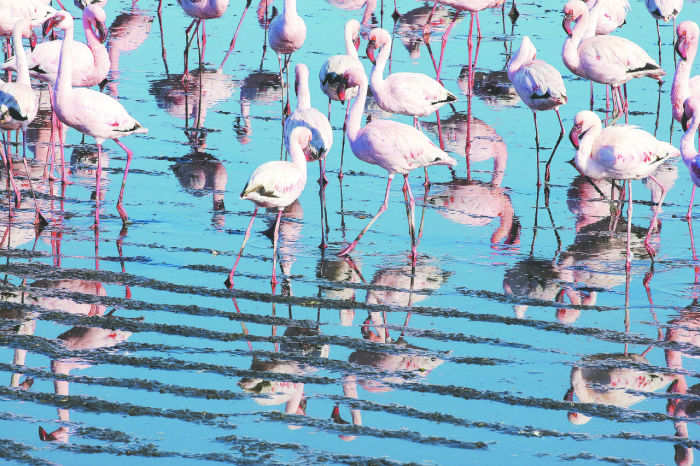We visited the Cradle of Humankind world heritage site, north of Johannesburg where our common human ancestors lived more than three million years ago. We climbed through one of the Sterkfontein Caves, where the fossil remains of a human ancestor Australopithecus africanus were found in 1947. The visitors’ centre Maropeng, which means “returning to the place of origin” in Setswana, the main local indigenous language, is an engaging mix of theme park ride and museum. You travel down a dark bumpy tunnel in an inflatable raft back in time to the Big Bang, to emerge into a large light-filled interactive museum with a similar feel to the Questacon National Science and Technology Centre in Canberra. It explores genetic diversity and evolution linking the Out of Africa story of humanity with the fossil finds in this archeologically rich part of South Africa. The final section of the gallery focuses on the human diversity both within South Africa and across the world and leaves visitors with questions of how our species will face future challenges for survival.
A highlight was the first night of our safari, camping at Dqae Qare San Lodge, a social enterprise owned by the San Bushmen in the middle of the Kalahari Desert. One of their elders shared stories that showed us how they lived in that arid part of Botswana and held echoes of life for remote Australian Aboriginal communities. Another highlight of the safari was to camp for two nights on an island in the middle of the Okavango Delta and be shown around by locals who poled our mokoro (canoe).
While Namibia and Botswana were amazing, it was some of the people and stories of struggle from South Africa that really struck a chord.
Australia may have boycotted South African sport in the 1970s to put pressure on a racist regime, but what impressed us about South Africa is that it now has prominent institutions, like the Apartheid Museum in Johannesburg, which acknowledge the truth of its history. In contrast, Australia still struggles with its black history and doesn’t yet have museums that adequately tell it from other than a mainstream white perspective.
All sides of the history of colonialisation, the apartheid era, the democratic elections in 1994 (only a year after the Mabo ruling when our high court overturned terra nullius) and the triumphs and disappointments with the Truth and Reconciliation Commission are told.
The temporary exhibition at the Apartheid Museum when we visited celebrated Journeys of Faith – Navigating Sexual Orientation and Gender Diversity, which told the stories of 12 South African people from different faith traditions. It truly is now a rainbow nation.
We visited St Georges Cathedral in Cape Town where Desmond Tutu was archbishop and still preaches many Fridays, but as we were there on a Sunday we heard the present minister grapple openly with the implied homosexuality in David’s grieving at the death of Jonathan in the Old Testament reading from 2 Samuel.
We found a different kind of synergy with Australia in Cape Town’s District Six Museum. It told stories all too similar to the experiences of people living in NSW public housing in Waterloo and Millers Point who are being displaced because the land they live on is now deemed too valuable for public housing.
District Six was established as a mixed community of freed slaves, merchants, artisans, labourers and immigrants in the late 19th century. Like Millers Point and The Rocks, District Six was a vibrant centre with close links to the city and the port. By the beginning of the 20th century, however, the process of removals and marginalisation had begun.
In 1901, black South Africans were displaced from the district and, as happened around the world, the more prosperous moved out from the inner city to the suburbs leaving the area to poor families from many different cultural backgrounds. The area became a neglected ward of the city.
On 11 February 1966 it was declared a white area and by 1982, the life of the community was over. Racial segregation laws were used to forcibly remove more than 60,000 people to barren outlying areas aptly known as the Cape Flats, and their houses in District Six were flattened by bulldozers.
So great was the reaction to the destruction of the community that over 30 years later most of the area is still not rebuilt. There are just large areas of green grass growing over the uneven ground left after the demolition.
In 1994, the old Methodist church on the edge of the district was transformed into a vibrant centre celebrating the lives and stories of the families and residents who were evicted. “Through this space we have created an arena which enables us to reaffirm our identity, celebrate our heritage and confront the complexities of our history.”
In Cape Town the Hop On, Hop Off tourist bus allows you to participate in a walking tour of one of the townships. We were disappointed that we were the only two people who got off the crowded bus that Sunday to take up the opportunity of a guided tour of Iminzamo Yethu Township with one of the township’s community development workers. His enthusiasm as he talked about his work empowering the next generation to gain an education was very like listening to Shane Phillips talk about his work in Redfern and Waterloo.
It was half a world away and yet there was so much reminding us of home. We have returned with a renewed appreciation for the strengths of our community and are back tackling the challenges that await us.





